









After a VERY long flight to Cairo, we spent our first day there
relaxing and getting over jet-lag by the hotel pool, and
learning the first lesson about the Arab mentality - nothing
ever turns out the way you had it planned! Our carefully
arranged day-by-day itinerary was literally turned upside down,
but in the end it all worked out, so we didn't argue too much
about minor details such as dates or times!
On the second day, off we went to the famous pyramids at Giza.
We got our first taste of Cairo traffic in the process...the
city is dusty and noisy to begin with, but you only really
appreciate how much so once you're stuck in a hot VW van in
round-the-clock rush hour traffic, surrounded by cars honking
their horn constantly for no reason at all, and pedestrians,
street-vendors and donkey-carts squeezing in and out between the
cars. One-way streets are completely ignored, of course!
Our next stop was of course the famous Sphinx. Somehow, we had
always imagined it to be larger than it really is. Still, its
front paws resting on the sand are about a man's height,
and the face radiates peace and serenity despite being badly
damaged and eroded.
On the way back to Cairo, we stopped at one of the several
papyrus institutes where we were shown how papyrus is actually
made, and where ancient tomb paintings are copied onto papyrus
sheets for the tourist trade.
Next day, the famous Cairo museum, for a glimpse of treasures,
statuary, and mummies, all taken from the tombs we would visit
later. Unfortunately, money is tight in Egypt, and to maintain
such a vast collection of artifacts properly takes much more than
is available - a very sad sight to see these fabulous things
in dark, dusty rooms, obviously deteriorating over time.
Onward, on a flight to Luxor, 680 km south of Cairo. Quite a
difference in climate - the heat is very, very dry, the air
much clearer and easier to breathe. Luxor is a lovely little
town, its main attraction the famous temple of Luxor, and a few
kilometers away, the temple of Karnak.
The temple at Luxor is similar to Karnak, except smaller. It is
also dedicated to Amun, and his likeness is seen everywhere,
carved into the massive walls and pillars. The great obelisk
still stands in the courtyard, a twin to the one now at the
Place de la Concorde in Paris.
Next morning, the Valley of the Kings...a dream come true! We
were ferried across the Nile to the West Bank and driven into
the valley on a winding road flanked by huge cliffs riddled
with holes, where archaeologists and tomb robbers had dug over
the years.
The first stop was the famous temple of Queen
Hatshepsut, the only female pharao ever to rule Egypt. The
temple is hewn out of the face of the cliff, an architectural
masterpiece of harmony, proportion and beauty. The walls still
bear traces of the original paintings. And finally, we were
actually descending into the famous tombs of kings and nobles,
deep down inside the rock. All tombs have the same basic
layout - a narrow, steep corridor down into the rock, opening
up into one or more chambers, sometimes square, sometimes dome-
shaped, some with square pillars supporting the ceiling, and all
painted in the most vivid, beautiful colours you could possibly
imagine. The walls along the entrance corridors are covered with
thousands of hieroglyphs, texts from the 'Book of the Dead', and
the burial chambers themselves depict scenes of mummification,
preparation of the deceased for the after-life, with the
various gods guiding him to the netherworld. It is very hot
and stuffy and one is very aware of the hundreds of tons of
rock above ones head...but you forget it all when faced with
these absolute artistic masterpieces. Everyone of course
wanted to see 'King Tut's' tomb, although it is one of the
more crudely made and does not have many wall-paintings. The
stone sarcophagus is still in place in the burial chamber, with
the outermost gold-covered coffin in the shape of the King's
body still lying in it, containing the King's mummy - the only
one to be returned to its rightful resting place rather than to
be on exhibit at the Cairo museum.
Some of the tombs we were able to enter had no electric lights
inside, and we felt very strange crawling into dark small
spaces deep within the earth, armed with a lantern whose light
suddenly made the invisible walls explode and come alive with
colorful figures and hieroglyphs. In some tombs, not even a
light was available, and the "guardian" of the tomb would sit
at the entrance with a large mirror, catching and directing the
sunlight into the tomb with it. Quite an exhausting adventure,
but worth it!
The next morning, we started our five-day cruise up the Nile.
It is a very relaxing journey, watching the banks of the great
river slowly glide by, seeing an occasional mud-brick village,
children leading water buffalo down to the water to drink,
farmers plowing fields in the same way they did thousands of
years ago.
It was hard to leave Aswan to fly back to dusty Cairo, but we
had one more 'expedition' planned - to Memphis and Sakkarah.
The road to Memphis follows the Nile valley, which is incredibly
fertile. Date palms, sugar cane and corn fields line the road.
Memphis is about 35 km south of Cairo and used to be the
capital of the Old Empire up until 350 A.D. All that's left of
a once great and powerful city are a few broken pillars, and
the beautiful 'Alabaster Sphinx', carved out of a single, huge
block of alabaster. The visit to Memphis and Sakkarah was a fitting
end to our journey in Egypt, leaving us with precious memories.
It is truly a land of opposites, rich and poor, squalid and
grand, fertile and desert-dry, and having had a glance at its
great past left us filled with awe at what people had been
able to create for their rulers and for us to enjoy thousands
of years later.
For more interesting reading about ancient Egypt, click here. This is the homepage for the Theban Mapping Project, detailing all tombs in the Valley of the Kings and other sites, as well as the ongoing excavations in "KV5", the tomb found by Kent Weeks, believed to have contained the mummies of some of Ramses II's sons.
A dream of a lifetime had finally come true for us as we set
out on a trip to Egypt, land of the pharaos, pyramids, buried
treasure and ancient grave robbers.
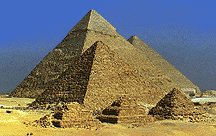 Finally, we arrived on the slightly elevated plateau of Giza,
and THERE THEY WERE! The scene had the unreality of a movie set -
your brain just can't take in that something like this actually
exists. The three pyramids, built around 2,600 B.C., are truly
awesome. The largest (Cheops) is 137 meters high and its summit
still bears traces of the original limestone coating that once
covered
the entire construction, which is made up of blocks weighing
2 1/2 tons each. The two smaller pyramids were built for the
Kings Chephren and Mykerinos. Cheops can actually be entered,
there is a shoulder-wide, very steep corridor leading up to
about mid-height inside the pyramid, ending in a chamber
containing an empty, broken sarcophagus. Not for people with
claustrophobia! The air is hot and stuffy, and the lighting
basic, to say the least!
Finally, we arrived on the slightly elevated plateau of Giza,
and THERE THEY WERE! The scene had the unreality of a movie set -
your brain just can't take in that something like this actually
exists. The three pyramids, built around 2,600 B.C., are truly
awesome. The largest (Cheops) is 137 meters high and its summit
still bears traces of the original limestone coating that once
covered
the entire construction, which is made up of blocks weighing
2 1/2 tons each. The two smaller pyramids were built for the
Kings Chephren and Mykerinos. Cheops can actually be entered,
there is a shoulder-wide, very steep corridor leading up to
about mid-height inside the pyramid, ending in a chamber
containing an empty, broken sarcophagus. Not for people with
claustrophobia! The air is hot and stuffy, and the lighting
basic, to say the least!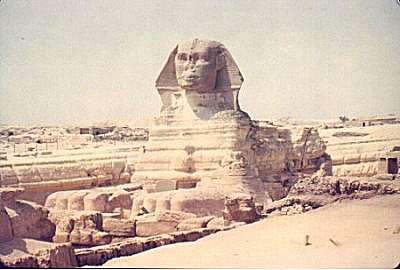
 Back in Cairo and up a narrow,
winding road to the ancient Citadel and the alabaster mosque
of Muhammad Ali. The mosque is a beautiful piece of architecture
with a classic half-dome in the center, flanked by two tall,
slender minarets. Inside, the floor is covered in lovely
carpets, the walls are carved alabaster, the windows wrought-
iron in intricate patterns.
Back in Cairo and up a narrow,
winding road to the ancient Citadel and the alabaster mosque
of Muhammad Ali. The mosque is a beautiful piece of architecture
with a classic half-dome in the center, flanked by two tall,
slender minarets. Inside, the floor is covered in lovely
carpets, the walls are carved alabaster, the windows wrought-
iron in intricate patterns.
Onward to the Khan el-Khalili bazaar, a maze of shops where you
could easily be tempted to wreck your entire holiday budget in
a few hours. Silver and gold work, inlaid boxes, alabaster
pieces, galabeyas (Egyptian caftans), rugs, semi-precious stones,
big burlap sacks full of delicious spices, henna and saffron.
Haggling is a must, and half the fun of buying!
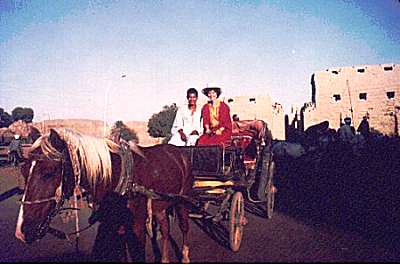 That's me in "native garb" taking in the sights of Luxor!
That's me in "native garb" taking in the sights of Luxor!
Karnak, dedicated to the god Amun-Ra, is a giant puzzle of many
temples from many different time periods added to one another.
Giant pillars once supported roofs, now gone, and you can still
see some of the original paint way on top of the pillars where
erosion and pollution haven't done their damage yet.
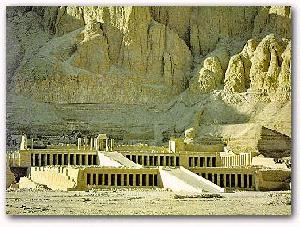

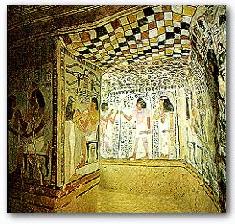

Feluccas at Aswan
The end of this part of our journey came at Aswan,
a beautiful
town and since ancient times one of the winter resorts for Egypt's
rulers.
A few kilometers west of Memphis is Sakkarah, the site of the
oldest stone structure ever built by man, the 'stepped pyramid'
of King Zjoser. This is the edge of the Sahara desert, and the
pyramid rises like a vision out of the blindingly white sand.
All around the pyramid are the Nobles' tombs, which contain
some of the most beautiful reliefs to be seen in Egypt. Unlike
the tombs in the Valley of the Kings, which only depict scenes
of death and the afterlife, these reliefs show the daily life of
the ancient Egyptians. They can be seen building ships, plowing
their fields, making wine, and tending their cattle. There is
a special feeling about descending from the hot surface of the
desert into the cool, below-ground tombs, where it is quiet
and peaceful.
